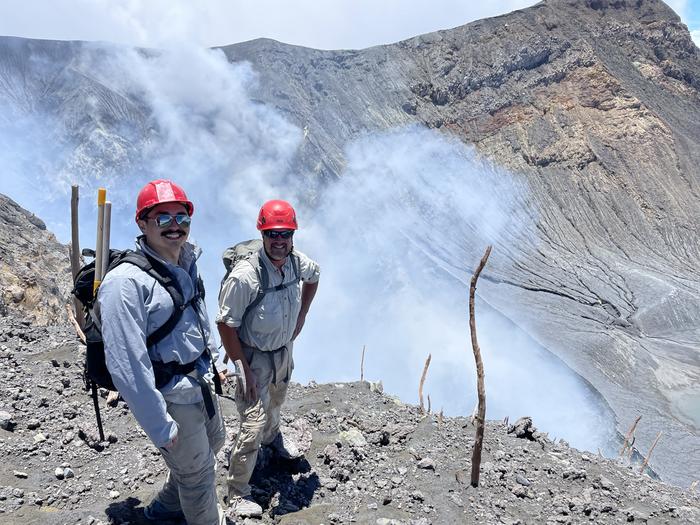New research is illuminating a critical yet often overlooked aspect of long-term human habitation on Mars: the potential health risks posed by the planet’s ubiquitous dust. This study brings together a diverse team of scientists, including those from the University of Colorado Boulder and the Keck School of Medicine at the University of Southern California. The investigation, which scrutinizes the chemical composition of Martian dust, reveals alarming implications for future astronauts who may spend extended periods on the Red Planet.
The findings suggest that prolonged exposure to Martian dust could lead to severe health issues, from chronic respiratory ailments to thyroid disease. The research identifies a broad range of chemical compounds found in Martian dust that might pose hazards when inhaled in sufficient quantities over time. This comprehensive study, published in the journal GeoHealth, marks a significant step towards identifying health risks associated with extraterrestrial environments.
Justin Wang, the lead author of the study and a medical student at USC, emphasizes that while exposure to Martian dust is not the most pressing danger astronauts might face, it is a solvable issue. With the right technology and preventive measures, the health risks tied to Martian dust could be effectively mitigated. He revealed that historical data from Apollo missions indicated similar health responses among astronauts who inhaled moon dust, highlighting the relevance of this research for upcoming crewed Mars missions.
A detailed examination of Martian dust unveils a disturbing array of ingredients potentially harmful to human health. These include silicate minerals and iron oxides, along with heavy metals such as beryllium and arsenic. Particularly concerning are perchlorates, a category of compounds that researchers have linked to both respiratory and thyroid issues in humans. While many of these harmful substances may be present in trace quantities, the prolonged exposure anticipated for astronauts living on Mars could amplify their health effects.
The researchers utilized a variety of data sources, including findings from Mars rovers and Martian meteorites, to grasp the dust’s composition better. Brian Hynek, a co-author and geologist at CU Boulder, underscores the necessity of characterizing Martian dust to anticipate and address potential health hazards. He points out that astronauts are likely to encounter significant dust on their spacesuits and should prepare for frequent dust storms, which could exacerbate exposure to these hazardous materials.
In a striking revelation, the study notes that the average Martian dust grain size is estimated at around 3 micrometers—so small that it’s significantly less than what human lungs can expel. This raises the alarming possibility that inhaled dust could penetrate deep into the respiratory system and subsequently enter the bloodstream, leading to a variety of health complications over time.
Wang’s journey into the realm of Martian dust stems from a unique academic background. After obtaining degrees in astronomy and biology, he pursued a master’s in aerospace engineering and enrolled in medical school. Presently serving in the Navy through the Health Professions Scholarship Program, Wang utilizes his diverse education to tackle this extraterrestrial health challenge.
In their research, Wang and his team delved into previous studies to outline potential health impacts tied to the chemical components of Martian dust. Their findings draw parallels to familiar health issues on Earth, such as silicosis, a condition afflicting those exposed to high levels of silica. Moreover, the high concentrations of perchlorates in Martian dust may interfere with human thyroid function, with the danger of very low exposure levels potentially posing serious health risks.
Recognizing that proactive measures are imperative, Wang emphasizes that preparation for the health risks associated with Martian dust should commence before astronauts even set foot on the planet. Strategies such as iodine supplementation could counteract potential thyroid dysfunction caused by perchlorates. Additionally, advanced filtration systems designed to effectively remove Martian dust could maintain clean air quality in habitat modules on Mars, crucial for safeguarding astronaut health.
The study concludes with a powerful message on the importance of prevention. Just as healthcare recommendations urge individuals to monitor cholesterol to avoid heart disease, similar foresight is essential for addressing the dangers of Martian dust. The future of human space exploration hinges on ensuring that astronauts can live and work safely on other planets, free from unnecessary health risks due to environmental hazards.
As space agencies continue to plan missions aimed at landing humans on Mars, this research serves as a critical reminder of the hazards that lie beyond the atmosphere. Understanding and addressing the health implications of Martian dust will be vital to the success of these missions, ensuring that astronauts can focus on their groundbreaking work rather than contend with avoidable health complications.
Should future Mars colonization efforts take into account the findings of this research, the potential for safer, healthier missions increases dramatically. By implementing the necessary preventive measures, we can pave the way for a successful human presence on Mars, where astronauts can explore, discover, and perhaps even establish a new home among the stars.
Subject of Research: Health impacts of Martian dust on astronauts
Article Title: Potential Health Impacts, Treatments, and Countermeasures of Martian Dust on Future Human Space Exploration
News Publication Date: October 2023
Web References: GeoHealth
References: DOI 10.1029/2024GH001213
Image Credits: Justin Wang
Keywords
Mars, dust exposure, astronaut health, respiratory disease, perchlorates, silicosis, preventive measures, space exploration.




